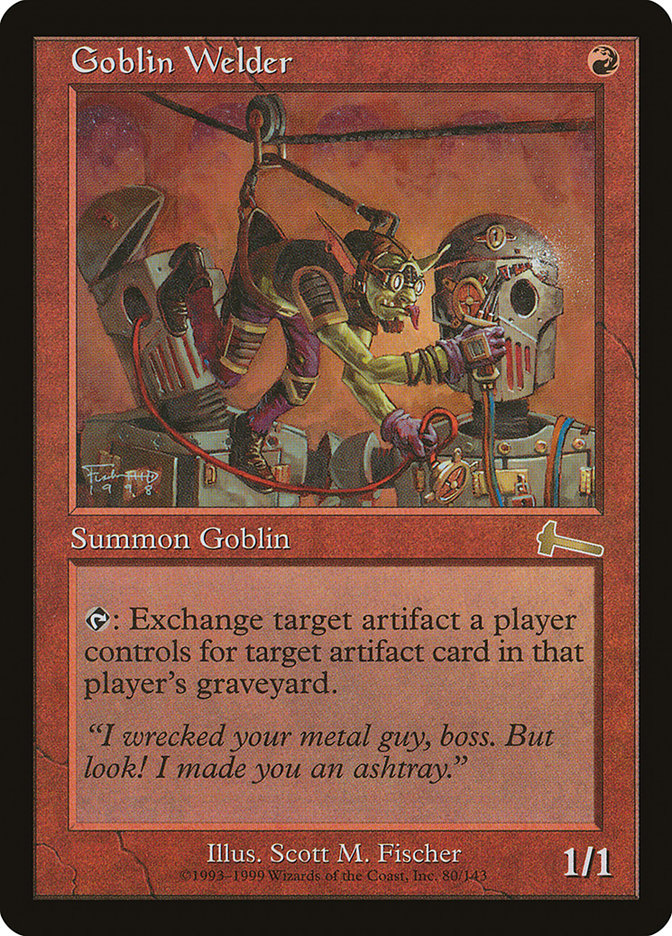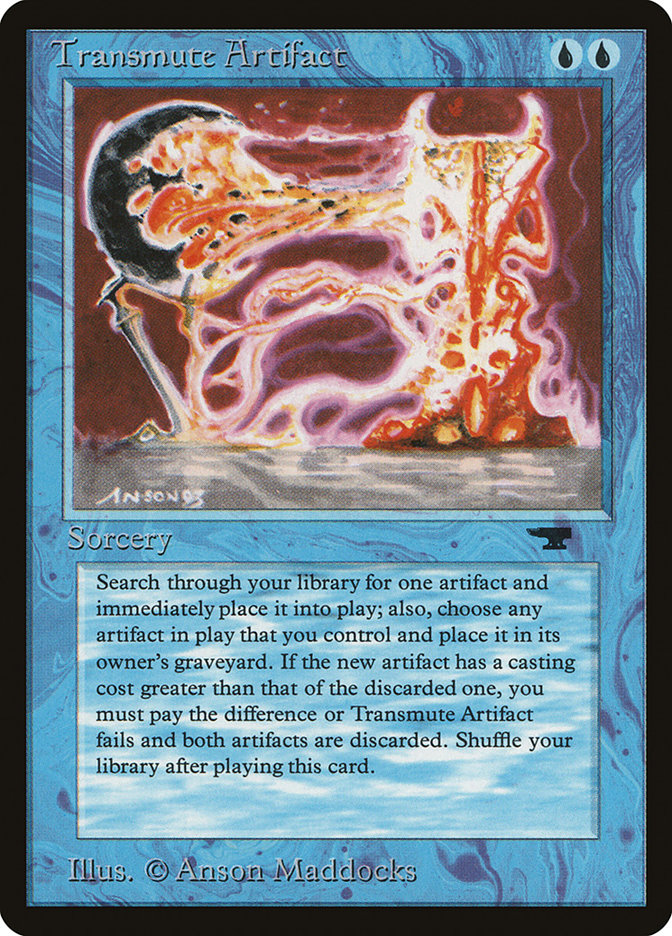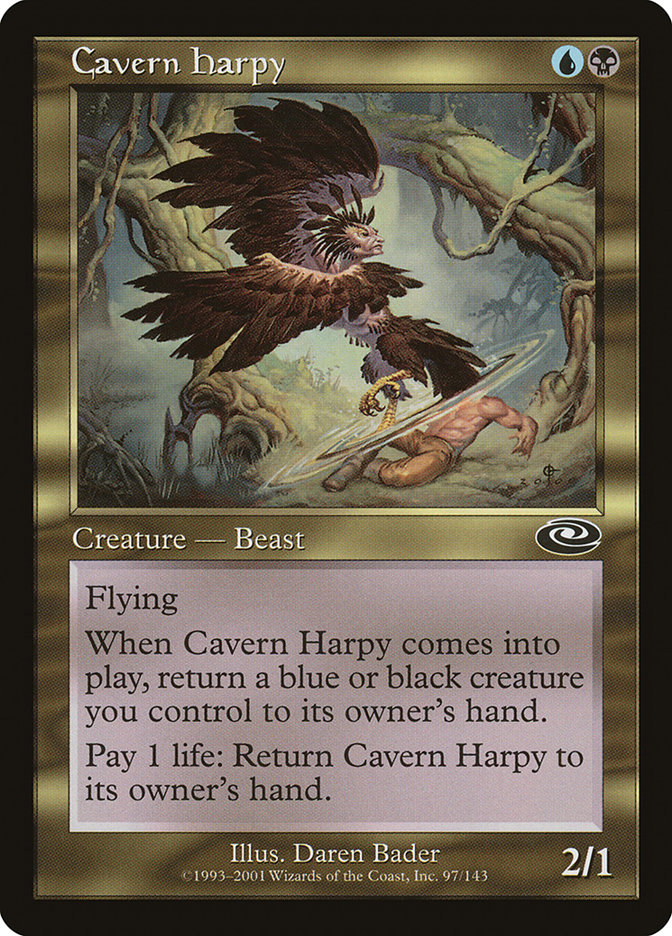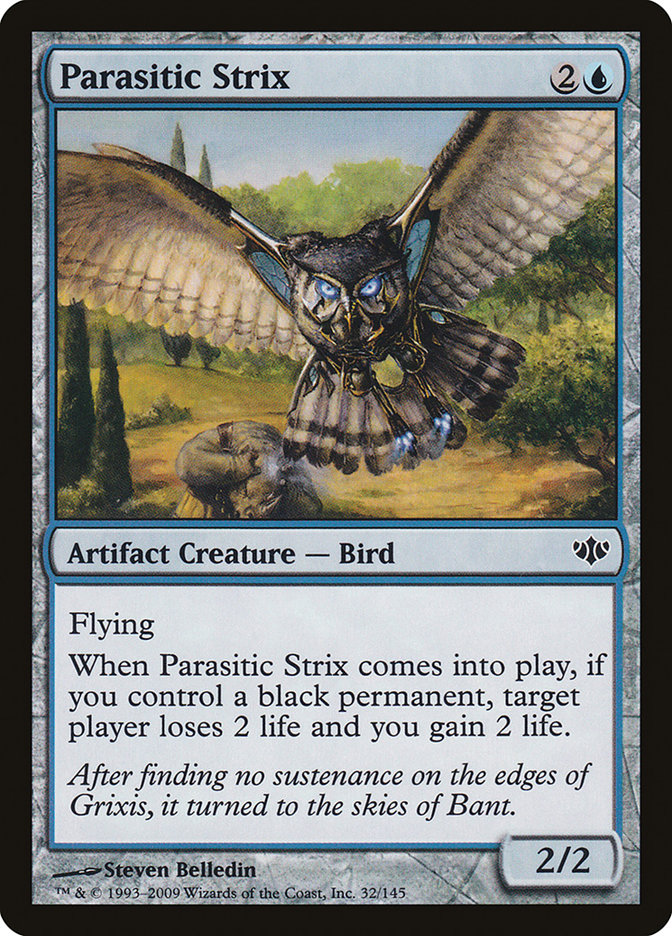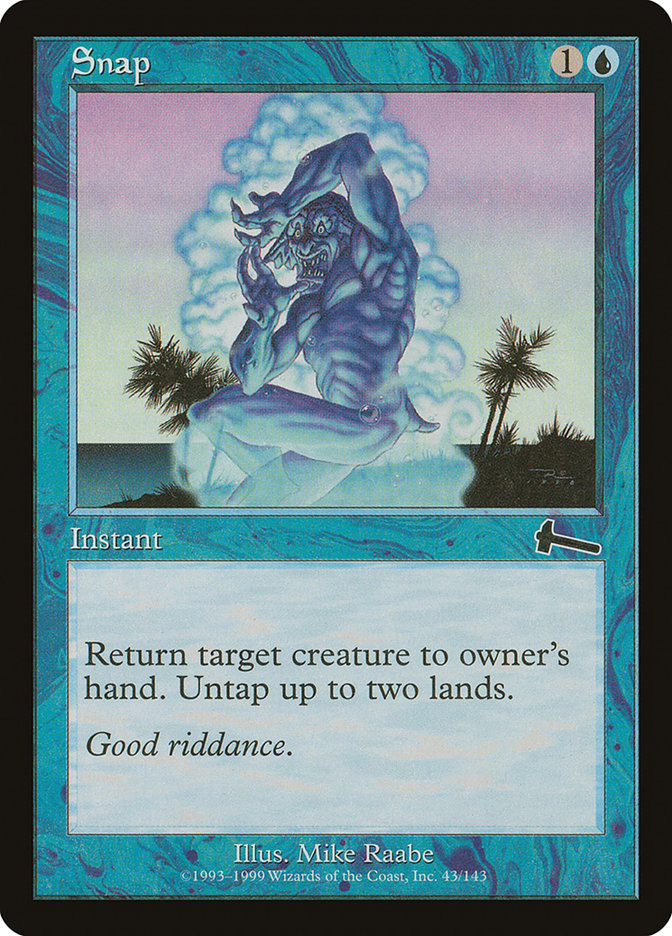I’ve mentioned it before, and I’m sure I’ll mention it again—Legacy is as much fun as it is because of the incredible amount of different decks you can choose to play and expect to do at least reasonably well with. A big part of this are the tier 1.5 and tier 2 decks, decks that likely aren’t the absolute best at executing their macro-strategy (combo, aggro, etc.) but are easily good enough to allow an experienced pilot to take home the trophy with a little luck.
And a couple of those are what I’d like to talk about today—some of the combo decks other than Show and Tell and Storm that are fun and quirky but still good enough to actually play without embarrassing yourself.
Paint It Blue
Well, if you read last week’s article, you know that I enjoy a nice bit of Goblin Welder action. The little Goblin that could has traditionally had a place in Vintage, yet its popularity never really carried over into Legacy. But it could:
Creatures (10)
Lands (19)
Spells (31)

Jacob Kory aka Koby on MTG The Source is an aficionado of weird yet broken combo decks and has a tendency to do well with them, as he was one of the first people to give Tin Fins a StarCityGames.com Legacy Open Top 8 or make it deep into a GP day 2 by porting the same ideas to the Modern format. As such, I’m not surprised to see him rocking this modernized version of what I know originally as a Caleb Durward brew from a couple of years ago (you can find his article on the deck here).
In case you don’t know the combo this deck is trying to abuse, when you activate a Grindstone with a Painter’s Servant in play, all the cards in the opponent’s library will share a color, and as a result their whole deck will end up getting milled.
So far, so good. But why would you run this combo over anything else? I mean, after all, we’re talking about a two-card combo involving a creature—and therefore susceptible to creature removal—that costs six mana to fully pull off (two to cast Painter, one to cast Grindstone, and three to activate it). In addition, it’s even vulnerable to someone having Emrakul, the Aeons Torn in their deck since the Eldrazi trigger will just reshuffle their graveyard into their library after Grindstone has finished resolving (unless you’ve also found your Tormod’s Crypt).
Nonetheless, there are a number of powerful arguments for going with this deck. Your kill is nearly instantaneous (they need to still draw a card admittedly), and both Painter’s Servant and Grindstone have some utility outside of just winning, whether it’s improving your Sensei’s Divining Top’s performance by milling away dead cards, turning the lands in your hand blue to have them to pitch to Force of Will, or simply straight-up blocking small guys.
The two biggest reasons to play this deck however are Goblin Welder and Transmute Artifact. I already talked about the power of Goblin Welder in Vintage last week, but the underplayed manipulator of artifacts has had a hard time finding a job to do in Legacy. He’s right at home in this deck though. He not only protects your combo from countermagic and draws out removal so that it won’t hit your Painter’s Servant, but he also enables a couple of pretty crazy shenanigans.
You can activate Grindstone and Weld it into Painter’s Servant in response, start drawing extra cards by flipping Sensei’s Divining Top in and out of play, or generate mana by turning tapped Grim Monoliths into untapped ones. It also interacts incredibly well with Intuition, allowing one card to find the full combo and fire it off in two Welds, which means you can go from just Welder to winning from one end step to your turn.
What you do is get Painter’s Servant, Grindstone, and Lion’s Eye Diamond; Weld in the first piece they didn’t give you on end step; untap; Weld in the second one; and play whatever they put in your hand. Lion’s Eye Diamond neatly makes sure you’ll have the mana to activate your Grindstone. Against the right matchup—say one that could threaten your Painter—you can also just dump a Wurmcoil Engine into the yard by finding both and bring that back to beat down with (and repeatedly switch in and out to make more and more Wurm tokens).
Speaking of Wurmcoil Engine, the artifact titan is part of the reason Transmute Artifact is so good in this deck. While it still has the power errata that keeps it from putting too expensive artifacts into play for long enough to trigger enters the battlefield effects, an untapped Grim Monolith pays for transmuting into Wurmcoil Engine almost on its own. Transmute Artifact can also serve as a pretty bad Entomb to make sure you have something powerful to do with your Goblin Welder. In this way Transmute Artifact gives you powerful things to do even when you have neither Painter’s Servant nor Grindstone while also being able to find either of your combo pieces.
This flexibility is what makes this such an excellent deck—in contrast to something like Sneak and Show that is running a lot of cards that are total bricks until you’ve found the other half of your combo, almost every card you draw here can fill a multitude of roles depending on the game state. And that’s what makes it so enjoyable to play and pretty tough to play against!
Voltron
Now to a deck that attracted a lot of attention back in 2007 just before Grand Prix Columbus only to be completely overshadowed once the Flash un-errata happened:
Creatures (14)
- 1 Eternal Witness
- 4 Imperial Recruiter
- 1 Cavern Harpy
- 4 Coiling Oracle
- 2 Dream Stalker
- 1 Venser, Shaper Savant
- 1 Parasitic Strix
Lands (21)
Spells (25)

Aluren wants to resolve its namesake enchantment and then build its own Tendrils of Agony by using Cavern Harpy to cast Parasitic Strix often enough to take the opponent down with a flurry of two-point life drains. Now, that’s a pretty terrible three-card combo, so clearly you aren’t trying to just draw into all the pieces naturally.
Instead, you use Imperial Recruiter to create a straight two-card combo with Aluren. The way there however is quite longwinded. You cast Imperial Recruiter for free and find another Recruiter to cast until you have all of them in play, at which point you find a Dream Stalker and cast that, bouncing Recruiter once again, and rinse and repeat for the other Dream Stalker. Then Recruiter finds Cavern Harpy, which bounces Dream Stalker to once again reuse a Recruiter so that the most expensive 1/1 in the game (I think?) can go ahead and find Parasitic Strix to finally complete the combo.
The reason you fetch out all those Recruiters and Dream Stalkers first is simple—it protects you from targeted removal. Since Dream Stalker doesn’t target, there is no specific Recruiter to blow up to mess with your plan, and correctly using the stack protects your actual kill from being weak to Swords to Plowshares, Lightning Bolt, or whatever else they might have (thanks to Aluren giving your guys flash).
What you’re supposed to do is this—play the Cavern Harpy first and put its gating trigger on the stack, and then play the Strix, drain them, and resolve the Gating trigger to bounce the Strix. Only now do you finally pay the life to bounce your Harpy. By using this sequence, you constantly have the option to bounce Cavern Harpy in response to anything they play, enabling you to replay it to save your Strix no matter when they plan to kill it.
Now that we know what the deck tries to do, we once again have to ask ourselves why we would play Aluren over something like Show and Tell. After all, we’re paying four mana instead of three and giving up quite a bit of redundancy because there’s nothing that can serve as a stand in for Aluren or Goblin Recruiter, so the deck is clearly worse as far as being a pure combo deck is concerned in spite of its kill being truly instantaneous.
The secret to Aluren’s power however is exactly that it does not have to play as a pure combo deck. Don’t get me wrong—you won’t end many games without casting your namesake enchantment and going off even though random beatdown can be more effective than you might think (just ask Elves). No, what really sets Aluren apart is that it’s perfectly adept at playing as a highly efficient midrange-control deck.
In contrast to many other combo decks, Aluren isn’t forced to ignore the opponent and just race for the kill. It has the ability to grind out massive card advantage or play an extremely disruptive game depending on the situation at hand, giving it the flexibility to choose the perfect role for this particular game instead of trying to replicate the same sequences over and over again.
Coiling Oracle, Imperial Recruiter, and Eternal Witness can all be hard cast and are all perfectly fine value plays as well as chump blockers, while Cavern Harpy or Dream Stalker can allow you to reuse some of them again to continue the value game.
The two most powerful interactions revolve around Intuition and Cabal Therapy however. Not only do you have Gitaxian Probe and creatures to really shred their hand with Therapy, but just casting Intuition for three of them will often allow you to strip the opponent’s hand completely bare and take the control role, whether it’s because they’re the faster combo deck or simply because you need to clear the way for your Aluren.
Intuition can not only turn into a weird kind of Mind Twist and find either Recruiter or Aluren to complete the combo, but it’s also the card that sets up a really absurd long game for a combo deck. By finding Volrath’s Stronghold, Life from the Loam, and whatever the best value creature you currently need, you can both break Brainstorm wide open and will get to recur that creature as often as necessary, especially if you have access to a couple of Cabal Therapys to sacrifice it to. This grinding tool also means you can recur Recruiter ad infinitum once Aluren is down to make sure your combo won’t be stopped by countermagic after you’ve exploited an opening. Sound alluring yet?
Winning (In) Response
Let’s end on another old-school deck that has received a number of new toys:
Spells (39)

I’ll be honest with you—this is the deck I’m least sure about as far as power level is concerned, though I believe it could be extremely well positioned in a True-Name Nemesis metagame. The problem is that it just hasn’t done anything major in years and my main personal experience with it is purely from goldfishing so I can’t truly evaluate how it should perform in the hands of a master. The reason I’m including it anyway is simple—Solidarity is the most fun deck to goldfish with I’ve ever encountered. Between all the insane tricks it’s capable of, I can only imagine how beautiful (and challenging) playing actual matches with it must be.
The whole deck is predicated on the idea of abusing Reset in a High Tide deck—untapping all your lands for two mana is incredibly powerful when they all produce multiple mana a piece. The hitch? You can only use Reset on your opponent’s turn, meaning you need your deck to be nothing but instants to really have it do work.
However, this little quirk also provides you with a huge upside—you always get to wait until the absolutely last possible moment to actually go off. With normal combo decks, you’re constantly forced to evaluate the board state and your opponent’s potential to decide if you have to go off now or can wait another turn to do more setting up and improve your chance of success. With Solidarity, you always get to milk time for all it’s worth.
The instant-speed nature of the deck also gives you a crazy amount of opportunities to play around all kinds of disruption. Say your opponent tries to interrupt your combo turn with countermagic or some other form of instant-speed disruption like Vendilion Clique. With a more regular deck, all you’d be able to do is to hope your in-hand disruption is enough to fight theirs. With Solidarity, on the other hand, you can just keep going off in response until you either win in spite of the counter or draw into another piece of protection to punch through the spell they’ve chosen to fight over.
This is particularly useful against soft counters like Spell Pierce and Daze. You all know the little trick of casting Dark Ritual in response to Spell Pierce in Ad Nauseam Tendrils to pay for the counter by using Ritual mana. Solidarity takes that play to the next level. After all, your combo engine mainly does two things: draw cards and produce mana. So if they’re trying to Pierce anything, all you need to do is to pull off another mana loop before letting it resolve and you can easily pay. Pretty sweet, huh?
The way Solidarity wins is as convoluted as it is straight forward and somewhat resembles that of the now-defunct Pauper Storm decks. Use your cantrips to hit your land drops, and once your opponent forces you to go off—either by playing a piece of disruption that would actually shut you down or by threatening to kill you—you kill them in response.
You’ll generally start off by casting High Tide—though I’ve seen the deck win without that signature spell if given the time to make sufficient land drops—and follow that up with draw effects—Meditate is key as it actually adds cards to your hand—until you run low on mana. Turnabout, Snap, or Reset then allow you to untap your lands, and the whole dance continues until you’ve either built up sufficient storm to Brain Freeze them or enough mana for a lethal Blue Sun’s Zenith. You can also combine the two to win on the spot for less mana.
Snapcaster Mage in particular is a godsend for Solidarity. Not only does it give you redundancy on your High Tides, Resets and Meditate— the deck’s most powerful enablers—but it also turns Snap into an incredibly powerful maindeck card for this version of High Tide. Snapcaster the first piece you need—which will oftentimes be High Tide—use Snap to bounce the Snapcaster and untap two lands, recast the Snapcaster targeting the Snap, and bounce it again. Not only have you just generated five storm for basically nothing with Snapcaster in hand to use again, but you also produced extra mana if more than one High Tide was active.
Combine this Snap play with Brain Freeze and you’ll be able to win with a surprisingly small amount of resources. This combination of cards for example even allows you to win on turn 2 (assuming two Islands in play):
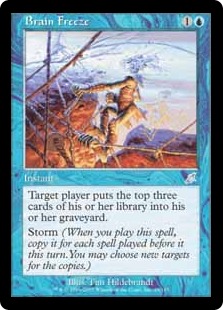
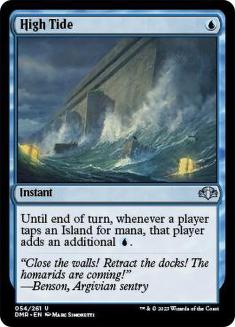


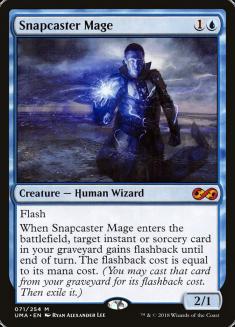
Cast High Tide into Reset (storm is two), Snapcaster Mage the Reset and cast it (storm is four), Snap the Snapcaster Mage (storm is five, UU floating), Snapcaster Mage the Snap and cast it on Snapcaster (storm is seven, UU floating). Replay Snapcaster Mage and Brain Freeze in response (mill 27 cards, storm is nine), target the Brain Freeze with Snapcaster Mage once it resolves and cast it again (storm is ten)—voila, you just milled them for 57 cards.
Now, that hand isn’t all that likely to happen admittedly, but neither is having to go off on turn 2 when you can win at instant speed anyway! You can also pull fun tricks like hijacking an opposing combo deck’s storm count to mill them out in response to an Ad Nauseam or Belcher activation, win thanks to their own draw effect when Reanimator activates Griselbrand (or just punish your opponent that way for casting a cantrip), or get rid of an Elves deck’s library when Natural Order threatens to resolve.
The incredible amount of flexibility gained from being an all-instant deck makes it not only absurdly fun but also makes you very good at fighting other combo decks. After all, you can always wait for them to sink resources into trying to win themselves and just go off before their kill has actually resolved.
And that’s why I think this deck is quite well positioned in a True-Name Nemesis metagame. Most players expected True-Name Nemesis to turn the metagame into a fight between combo decks that can ignore Nemesis, midrangey Nemesis decks focused on abusing the new bad boy, and even grindier decks built in ways that allow them to easily answer the card. Lo and behold, that’s exactly what seems to be happening when we look at recent Top 8s like last weekend’s SCG Open in Indianapolis.
Now, Solidarity’s biggest problem has always been speed. Because of the deck’s instant-speed nature, you can’t use Merchant Scroll or the most powerful backup cantrips (Ponder and Preordain), and as a result the deck can sometimes be a little slow to find the pieces it needs—High Tide in particular. But take another look at the decks that gained in popularity as a result of True-Name Nemesis. The metagame has slowed down noticeably outside of combo decks, and against those Solidarity already has a strategic edge due to its inner workings. In short, if there’s ever a time for Solidarity to shine in modern Legacy, it sure looks like it should be now.
Destination Reached
Well, there you go—three combo decks for you to play if you want to broaden your horizons and do something a little different. I can tell you from firsthand experience that playing the same deck over and over again has a tendency to get old at some point no matter how good or fun that deck is. If you’re like me and looking to take a little break from your old standby to recharge your mental batteries, one of these might be exactly what you’re looking for.
To those of you that want to change it up but aren’t interested in comboing the opponent out, don’t despair. I may have written about combo today because these are three decks I particularly enjoy, but similar variety can be found for most strategies. Assuming enough of you enjoyed reading about these under-the-radar decks, you could even end up finding some more in a future article of mine, so let me know! And if you’re already a champion of something powerful that’s largely ignored, go ahead and let me know about that as well. I could feel like highlighting your baby in the next one.
Until next time, take the path less traveled by!
Carsten Kotter

